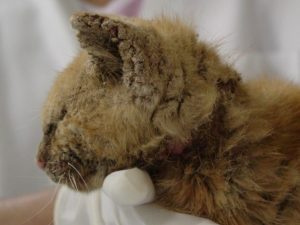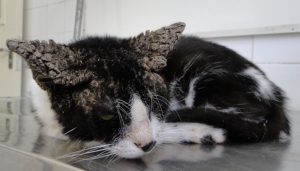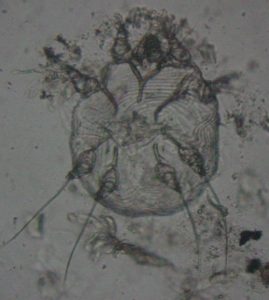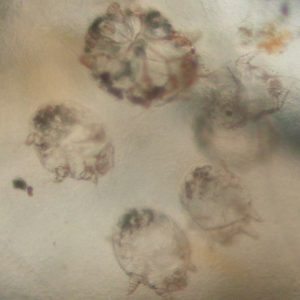3.6 Feline Notoedric Mange
Learning Objectives
- Know how common feline notoedric mange is.
- Describe the clinical signs associated with notoedric mange.
- Know if notoedric mange is contagious to other domestic animals.
- Know if notoedric mange is a zoonotic disease.
- Know how easily the mites can be found on skin scrapings.
- Know how to manage feline notoedric mange.
-
General Considerations
- Notoedric mange is a rare feline disease but it is endemic in a few areas.
- This is the sarcoptiform mite of cats.
- It is highly contagious to other cats and to humans (transient lesions). It rarely causes disease in dogs, rabbits and foxes.
- The disease is transmitted by direct contact.
- The mites burrow in the epidermis, mate and lay eggs.
- Mites complete the whole life cycle on the host but can live in the environment for 3 to 4 days.
-
Cause
- Notoedres cati.
- The mite belongs to the family Sarcoptidae (same family as Sarcoptes scabiei var. canis).
- Notoedres cati is smaller than Sarcoptes scabiei var. canis and its anus is located dorsally.
-
Clinical Signs
- Intense pruritus especially of the head and neck region.
- Lesions consist of alopecia, crusts, and miliary dermatitis. Skin lichenification occurs in chronic cases.
- Body areas typically affected include ears, face, and neck. It may extend to the feet and perineum.


-
Diagnosis
- Differential diagnoses include:
- Ear mites.
- Cheyletiellosis.
- Flea allergy.
- Food allergy.
- Dermatophytosis.
- Pemphigus foliaceus.
- Multiple skin scrapings until capillary bleeding is noted. Mites are easy to find in contrast to sarcoptic mange cases.
- Differential diagnoses include:


-
Treatment
- Most insecticides are toxic in cats.
- Lime sulfur as a 2% lukewarm water solution (4oz/gal), every 5-7 days for 6 to 8 treatments.
- Ivermectin (Ivomec®; Merial) 200 to 300 µg/kg (0.2 to 0.3 mg/kg) given subcutaneously or orally. Three treatments 2 weeks apart.
- Doramectin at a dose of 200 to 300 µg/kg (0.2 to 0.3 mg/kg) given subcutaneously once.
- Selamectin (Revolution®; Zoetis) applied topically once or twice every 14 to 30 days.
- Imidacloprid 10%/moxidectin 1% product (Advantage Multi® for Cats; Bayer) has been effective after one application.
- Fipronil (Frontline® Spray; Merial) was anecdotally reported to be beneficial. Do not use if performing a treatment trial.
- Fluralaner (BravectoTM; Merck) and other isoxazolines have been shown to be effective for sarcoptic mange in dogs and may be also efficacious for notoedric mange. However, no studies or case reports have been published to support this claim. BravectoTM Topical Solution (spot-on) is available for cats.
- Other cats in the household should be treated.
- Thorough cleaning of the household is recommended.
- People in the household may have transient pruritus and a papular rash. Lesions in people usually regress within 3 weeks after the animals are treated.
Important Facts
- Notoedric mange is a very pruritic dermatosis of cats.
- Notoedres cati belongs to the same family as Sarcoptes scabiei.
- It is very contagious to other cats.
- It is also contagious to people.
- Thick crusts are initially seen on the face and neck and later on the feet and perineum.
- Mites are easily found on skin scrapings.
- Lime-sulfur is a safe and effective therapy, but there are other new and safe options.
References
Foley RH. Parasitic mites of dogs and cats. Comp Cont Educ 1991; 13: 783-799.
Leone F. Canine notoedric mange: a case report. Vet Dermatol 2007; 18(2): 127-129.
Miller WH, Griffin CE, Campbell KL. Small Animal Dermatology, 7th edn. St. Louis, MO: Elsevier, 2013; 319-320.
Scott DW, Miller WH, Griffin CE. Small Animal Dermatology. 5th edn. Philadelphia: W.B. Saunders Co., 1995; 441-443.
Zhou X, Hohman AE, Hsu WH. Current review of isoxazoline ectoparasiticides used inveterinary medicine. Vet Pharmacol Ter 2022; doi: 10.1111/jvp.12959.

